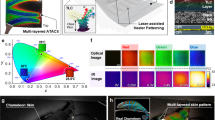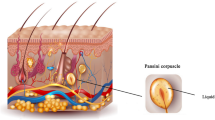Abstract
In this study, we develop a camouflage robot that collects substances from the environment. Many researchers in the field of bio-inspired robotics have reported artificial skins such as skin imitation and skin reproduction. Unlike typical study, we focus on another approach to create skins inspired from a bagworm. Bagworm collects substances from the environment as the exterior and obtains camouflage effect to protect itself from external enemies. In a similar fashion, the developed robot collects the substance from the environment to blend into the environment without a big external device. The developed robot can change the camouflage effect according to changes in the environment. We conducted some experiments to evaluate the proposed approach and confirmed its effectiveness of the proposed approach.














Similar content being viewed by others
References
Wang Z., Deng K, Bian Q, Dai Z (2019) A gecko-inspired robot employs scaling footpads to facilitate stable attachment. In: Yu H, Liu J, Liu L, Ju Z, Liu Y, Zhou D (eds) Intelligent robotics and applications. ICIRA 2019. Lecture Notes in Computer Science, vol 11742. Springer, Cham
Wang Z, Wang Z, Dai Z, Gorb SN (2018) Bio-inspired adhesive footpad for legged robot climbing under reduced gravity: multiple toes facilitate stable attachment. Appl Sci 8:114
Kozuki T, Hirose T et al (2016) Skeletal structure with artificial perspiration for cooling by latent heat for musculoskeletal humanoid Kengoro. In: Proceedings of 2016 IEEE/RSJ International Conference on Intelligent Robots and Systems (IROS), Daejeon, 9–14 October 2016, pp 2135–2140
Li Q, Li J et al (2017) Engineering of carbon nanotube/polydimethylsiloxane nanocomposites with enhanced sensitivity for wearable motion sensors J Mater Chem C 5:11092–11099
Hou C, Huang T et al (2013) A strong and stretchable self-healing film with self-activated pressure sensitivity for potential artificial skin applications. Sci Rep 3:3138. https://doi.org/10.1038/srep03138
Zou Z, Zhu C et al (2018) Rehealable, fully recyclable, and malleable electronic skin enabled by dynamic covalent thermoset nanocomposite. Sci Adv 4(2):eaaq0508
Kao CH-L, Holz C et al (2016) DuoSkin: rapidly prototyping on-skin user interfaces using skin-friendly materials. In: Proceedings of the 2016 ACM International Symposium on Wearable Computers, September 2016, pp 16–23
Bandodkar AJ, Jia W et al (2015) Tattoo-based noninvasive glucose monitoring: a proof-of-concept study. Anal Chem 87:394–398
Srikanth V, Ramesh P et al (2013) Invisibility system using image processing and optical camouflage technology. Int J Eng Trends Technol 4(5):1874–1877
White SR, Moore JS, Sottos NR et al (2014) Restoration of large damage volumes in polymers. Science 344(6184):620–623
Terryn S, Brancart J, Lefeber D et al (2017) Self-healing soft pneumatic robots. Sci Robot 2(9):eaan4268
Author information
Authors and Affiliations
Corresponding author
Additional information
Publisher's Note
Springer Nature remains neutral with regard to jurisdictional claims in published maps and institutional affiliations.
About this article
Cite this article
Nozawa, A., Matsumoto, M. A camouflage robot that collects substances from the environment. Artif Life Robotics 26, 42–51 (2021). https://doi.org/10.1007/s10015-020-00611-9
Received:
Accepted:
Published:
Issue Date:
DOI: https://doi.org/10.1007/s10015-020-00611-9




